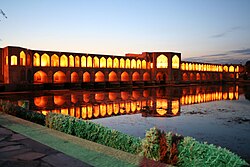
Back جسر خاجو Arabic Xacu körpüsü Azerbaijani Pont Khaju Catalan Pol-e Chādschu German Khaju-ponto Esperanto Puente Khaju Spanish پل خواجو Persian Pont Khadjou French Խաջու կամուրջ Armenian Jembatan Khaju ID
Khaju Bridge | |
|---|---|
 | |
| Coordinates | 32°38′12″N 51°41′0″E / 32.63667°N 51.68333°E |
| Crosses | Zayanderud |
| Locale | Isfahan, Iran |
| Characteristics | |
| Design | Arch bridge |
| Material | Stone and brick |
| Total length | 137 m (449 ft) |
| Width | 12 m (39 ft) |
| No. of spans | 21 |
| History | |
| Construction end | 1650 |
| Location | |
 | |
The Khaju Bridge (Persian: پل خواجو, Pol-e Xāju) is one of the historical bridges on the Zayanderud, the largest river of the Iranian Plateau, in Isfahan, Iran. Serving as both a bridge and a weir, it links the Khaju quarter on the north bank with the Zoroastrian quarter across the Zayanderud. It is located at the end of Kamal Ismail Street in Isfahan.[1]
The bridge served a primary function as a building and a place for public meetings in the past.[2][3] It has been described as the city's finest bridge.[3]
Persian art historians and revivalists, Arthur Upham Pope and Phyllis Ackerman are interred in a mausoleum nearby.[4]
- ^ Isfahan book (Lotfollah Honarfar), 1977, pocket books company, page 98
- ^ Mainstone, Rowland J. (1998). Developments in Structural Form. Architectural Press. p. 261.
- ^ a b Burke, Andrew; Elliot, Mark (2008). Iran. Lonely Planet. p. 243.
- ^ Erdbrink, Thomas (2014-04-14). "American's Wish for Iranian Burial Riles Hard-Liners". The New York Times. ISSN 0362-4331. Retrieved 2021-09-10.
© MMXXIII Rich X Search. We shall prevail. All rights reserved. Rich X Search